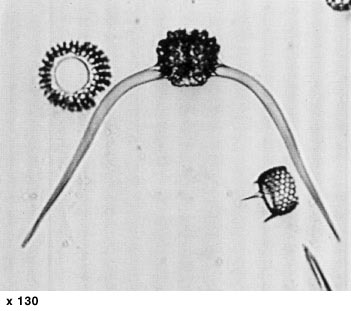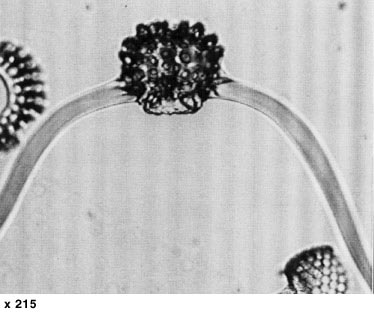 Dorcadospyris
ateuchus (Ehrenberg)
Dorcadospyris
ateuchus (Ehrenberg) Dorcadospyris
ateuchus (Ehrenberg)
Dorcadospyris
ateuchus (Ehrenberg)Ceratospyris ateuchus Ehrenberg 1873, p.218; 1875, pl.21, fig.4D
Cantharospyris ateuchus (Ehrenberg), Haeckel, 1887, p.1051; Riedel, 1959, p.294, pl.22, figs.3-4
Dorcadospyris ateuchus (Ehrenberg), Riedel and Sanfilippo, 1970, p.523, pl.15, fig.4
Dorcadospyris(?) or Petalospyris(?) ateuchus (Ehrenberg), Petrushevskaya and Kozlova, 1972, p.532
Shell nut-shaped, tuberculate, thick-walled, with indistinct sagittal stricture and with subcircular to circular pores without regular arrangement. Two primary feet robust, circular in section, usually tending to be straight, though in some specimens curved, with convexity outward. Secondary feet not present in all specimens, one to four in number, much smaller than the primary feet. In some specimens a small amount of irregular lamellar meshwork is developed in place of the secondary feet. In many specimens a small apical horn is present. The one specimen that could be observed from the base was found to have three large and six small collar pores, similar to those of Tristylospyris triceros, and the primary spines correspond in position with the bars that Bütschli (1882) designated as e in his figure of the collar structures of Petalospyris argiscus Ehrenberg (Riedel, 1959).
 DIMENSIONS
DIMENSIONSBased on 30 specimens. Length of shell 63-98 µm; of primary feet 190-720 µm; of secondary feet 20-188 µm. Breadth of shell 78-120 µm (Riedel, 1959).
Two primary feet robust, circular in section, tending to be straight and divergent. In some specimens there are one to four small secondary feet, sometimes replaced by irregular meshwork (Riedel and Sanfilippo, 1978a).
Dorcadospyris ateuchus differs from its ancestor Tristylospyris triceros by the number of primary feet being reduced from three to two, and from its descendant Dorcadospyris praeforcipata Moore (1971, p.738, pl.9, figs.4-7) by the feet being straight rather than semicircularly curved, and in the apical horn being less well developed (Sanfilippo et al., 1985).
The nut-shaped lattice-shell bears two strong, obliquely downwardly directed primary feet, which are straight or slightly reflexed, and shorter, variably developed secondary feet which are cylindro-conical or lamellar. Apical horn weakly developed or absent (Sanfilippo et al., 1985).
This species is common in assemblages of late Oligocene to early early Miocene age from low and middle latitudes of all oceans. The evolutionary transition of this species from Tristylospyris triceros defines the base of the Dorcadospyris ateuchus Zone. Its morphotypic last appearance is approximately synchronous with the lower limit of the Stichocorys wolffii Zone.
Additional illustrations can be found in Moore, 1971, pl.8, figs.1-2; Ling, 1975, pl.5, figs.3-6.
Holdsworth (1975) noted a number of specimens, n. aff. ateuchus, "possessing a third, weak foot of circular cross-section and/or lacking the symmetry of D. ateuchus."